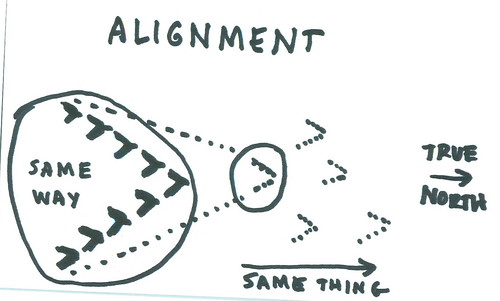Some people think of organizational alignment as "getting people to buy in" with an idea that is already formed. This may be useful sometimes but I don't think it's optimal.
Alignment is the process of synthesizing varied opinions and viewpoints on a subject.
Getting alignment on "why we're doing this is not about getting everyone to see "the right answer" so much as incorporating everyone's viewpoint into a "shared vision" of what that means.
Cultural alignment can mean "same thing" as in, "we are all driving toward the same goals" (true north) or it can mean "same way" as in, "we do things consistently."
A flock of geese does both -- can a modern organization work in the same way without stifling creativity?
Keep in touch! Sign up to get updates and occasional emails from me.

9 comments:
Aligning people with your goals, and convincing them with your ideas is a tough challenge making them go along with you is tough
To me, Alignment in an organization is a direct consequence of a good leadership. Let me explain:
A leader is a person with good communication skills that shares his vision and goals and motivates the people to joins him.
But a real leader requires much more than a charismatic personality. Those old authoritarian guys are not welcomed today.
A leader knows that doesn't have all the knowledge and all the answers. That's why needs to work with other people in a collaborative way.
One good leader never looses THE GOAL and is adaptable to the changes of the environment.
This alignment must be flexible and all the persons involved have to be informed permanently about the changes of the path.
Well, that's how I think, based on my own experience as a member of several crews. I've had good and bad leaders. I saw the best performance and results working with the good ones.
I think that cultural alignment, pointed somewhere in the middle, named "same thing", hides behavioral patterns! You name the point actually with titles such as "same goals", furthermore "consistently". I think that "productivity" seeks for alignment in the above areas! Especially when cultural communication and behaviorism takes place in the workplace!
Alignment too often comes before the idea behind which all is to be aligned is fully developed. The issues then becomes keeping everyone moving in the same direction when everyone begins to explore more appropriate directions.
Leadership can demand followers. Or, leadership can indicate a concept and let the alignment form organically, through creativity percolating up from the bottom. Buy in is essential.
This is especially true with innovation initiatives. It cannot be dictated from the top.
i agree -- adding to alignment been a function of behaviour and leadership. Very true. I will add that the most important element of alignment is TRUST. Without trust, concepts such as empowerment and alignment simply don't work. This is especially true in post-merger situations where a lot of work isa put into 'alignment' but very little is done to mend the trust which is inevitably damaged during the deal process.
i agree -- adding to alignment been a function of behaviour and leadership. Very true.
Working in instructional design, I think of alignment as a relationship between means, ends and what you value. What you measure, and how you choose to measure it, has to align with the learning experiences you create. Otherwise you cannot evaluate the learning or the teaching effectiveness. Organizations need the same coherence if they are to be productive.
Of course learning is not a neat input to output process. Learning follows many paths to many different conclusions, most all of which can enrich the overall knowledge and understanding of a community. So organizations need to allow space for exploration, ambiguity and experimentation -- social networks, think tanks, communities of practice, professional development, etc. That space will produce innovation, insight and critical self reflection. As long as there is agreement on fundamental values, then the outcomes should be constructive to the organization
To me alignment in a corporate environment is achieved when everything your people do and think about your business is in harmony with your vision and values. Hard and seemingly abstract, but think about it... It's connecting the 30,000 feet view with the 50 feet; it's the same like as drilling a tunnel from opposite ends and meeting in the same place.
I agree Joaquin,
We talk a lot about the 30,000-foot-view, or the satellite view, and the ground perspective.
What I think we need, and what we try to do at XPLANE, is to achieve the "traffic helicopter view" -- the view where you are high enough to see how all the parts fit together, but still low enough to see exactly what is happening.
Post a Comment